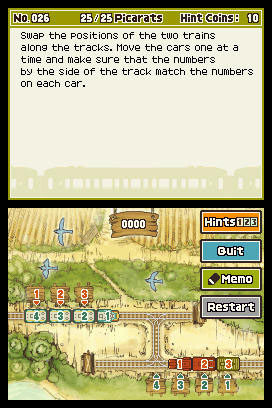Professor Layton and Pandora’s Box
Publisher: NintendoPlatform: Nintendo DS exclusive
UK Price (as reviewed): £26.99 (incl. VAT)
US Price (as reviewed): $29.99 (excl. Tax)
It’s not often we’re far enough away from our PCs that we get a chance to look at a handheld games platform and these days we’re too busy playing little iPhone games to bother whipping out our DSs.
But then, the Professor Layton games aren’t any normal games. The unique blend of gentle comedy, twee visuals and brain-breaking riddles is one that grabbed our attention from the moment it was announced. Pandora’s Box, the second game in the series (also known as The Diabolical Box or The Elysian Box depending on which territory you hail from) is no exception.
For those of you not in the know, it’s best to think of the Professor Layton games as a new type of point and click adventure game – one where the puzzles aren’t worked carefully into the environment but are instead rammed down your throat at every opportunity. It sounds like a bad thing, but it really isn’t; the game is so adorable and self-aware that being force fed the constant stream of conundrums is more delightful than it is damning.
Played from the first person perspective, the story follows ever-gentlemanly Hershel Layton, acclaimed professor of archaeology and general Jonathon Creek-alike as he and his young cockney apprentice, Luke, pay a visit to Layton’s mentor, Andrew Schrader. Claiming to have gained possession of a supposedly cursed box that will kill anybody who attempts to open it, Schrader thinks he’s cracked the case and calls Layton and Luke for assistance.


So don't open it then, idiot!
When Layton arrives on the scene however, Schrader is dead and a visibly distraught Professor suspects foul play evidenced by the missing box. The only clue they’re able to find is a ticket for the luxury steamtrain, the Molentary Express – a ticket which curiously has no destination. Despite insisting that he’s not a worthy detective, the Professor and his assistant nevertheless set out to solve the mystery surrounding Schrader’s death – with the unstated aim being to crack the mystery of Pandora’s Box for themselves.
The interesting thing about story is that, despite the fast-paced feel of the plot and the murder-mystery theme, the actual pacing of the game is typically slow and cerebral. There’s no combat or chase sequences, just a quiet and very British cast who’ve been married to a plain, pastel art style that’s reminiscent of Belleville Rendezvous and other French animations. The gameplay is similarly structured, with your sole role in the game being to move from scene to scene clicking on persons of interest and watching the dialog unroll automatically.
It’s here that the riddles come in, with the Professor’s reputation meaning that everyone you encounter wants to present you with a puzzle of some sort, or the Professor himself giving Luke conundrums as part of his tutelage. These aren’t your usual adventure game puzzles either – but explicit riddles or logic problems, like the one below which was our favourite from the previous Layton game.
Imagine a digital clock which displays only hours and minutes and works on a 12-hour basis, not 24 hour. How many times will the clock display three or more of the same number in a row over the course of a single day?
Don’t be ashamed if you can’t crack it easily – it’s harder than it looks and bit-tech developer Jamie was so stumped he eventually had to code a program to solve the puzzle for him. Let us know your answers in the forums.

MSI MPG Velox 100R Chassis Review
October 14 2021 | 15:04










Want to comment? Please log in.